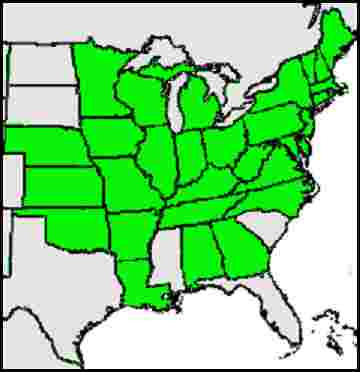Dwarf Chestnut Oak
(Quercus prinoides)
The Dwarf Chestnut Oak is a small deciduous tree native to much of the eastern and central United States. It gets its name from its toothed elliptically-shaped leaves, which resemble those of a chestnut tree. Another common name for the species is Dwarf Chinkapin Oak. The plant is a member of the white oak family and a cousin of the Chestnut (or Rock) Oak.
Quercus prinoides usually doesn't grow more than 20 feet tall, and it begins producing acorns at a young age, often when only three or four years old. Unlike many oaks, once it starts bearing, it has a good crop almost every year. Its acorns are also less bitter and more palatable to wildlife than those of most other oaks.
The tree can be used as a combination landscaping and wildlife plant. It is small enough and attractive enough to put into borders and gardens, where its leaves can turn a blazing orange-red before dropping in autumn. It can also be incorporated into a semi-wild area, where a grouping of several plants can quickly create an excellent wildlife habitat. Note that acorns are a primary food for many bird species, including Wood Ducks, Ruffed Grouse, Quail, Wild Turkey, Grackles, Jays, Nuthatches, Thrashers, Titmice, Towhees, and Woodpeckers. They also constitute a large part of the diet of Bears, Raccoons, Squirrels, Chipmunks, Deer, and Peccary.
There are several other small native oaks, including Georgia Oak (Quercus georgiana), Bluejack Oak (Quercus incana), and Bear Oak (Quercus ilicifolia). Bear Oak reportedly got its name from the early settlers' opinion that only a bear would eat its extremely bitter acorns.
Quercus prinoides is more widespread than the other small oaks, with a distribution that covers most of the eastern half of the country. It is a tough plant that can resist drought and grow in poor soils. But it is thinly spread over much of its range, and has become rare in many areas.
If you have the space, you should also consider planting the larger oak species. Every year in the United States thousands of large old oaks are cut down, but far fewer are planted. Many of the destroyed trees are at least a hundred years old, and it would take that long to grow similar-size replacements. In fact, some of the large oaks can live for five hundred years. If you want to leave a lasting legacy to the future, plant one (or several) now. No tree is more majestic, and it's hard to find a better wildlife plant.
The following information applies to the Dwarf Chestnut Oak.
Other Information
Scientific Name: Quercus prinoides
Common Names: Dwarf Chestnut Oak, Dwarf Chinkapin Oak
Plant Type: Small deciduous tree
Height: 15 to 20 feet
Cultivation Zones: 5 to 8
Native Habitat: Both lowlands and rocky ridges in open spaces and edges of forests
Native Range: Much of the central and eastern United States. The following map shows states with reported occurrences.

Conservation Status: NatureServe lists Quercus prinoides as Critically Imperiled in Delaware, Indiana, Vermont, Virginia, and West Virginia; Imperiled in Georgia, Nebraska, and Rhode Island; Vulnerable in Iowa and Maryland; possibly Vulnerable in Missouri and New Jersey; and possibly Extirpated in North Carolina.
Cultivation: Dwarf Chestnut Oak can survive in adverse conditions, but will grow faster and produce better crops in good soil and a sunny location. Avoid alkaline or poorly-drained soil. Because of its long taproot, you should try to get a small specimen. As it grows, you can prune it into either a shrub or tree form. A grouping of several plants might give better pollination and acorn production. Go to Cultivation for more information.
Plant Sources: Possible suppliers of Quercus prinoides include Woodlanders, Forest Farm, Oikos Tree Crops, and Nearly Native Nursery. Look for a small size. For links to the mentioned suppliers, go to Sources of Plants.
|

